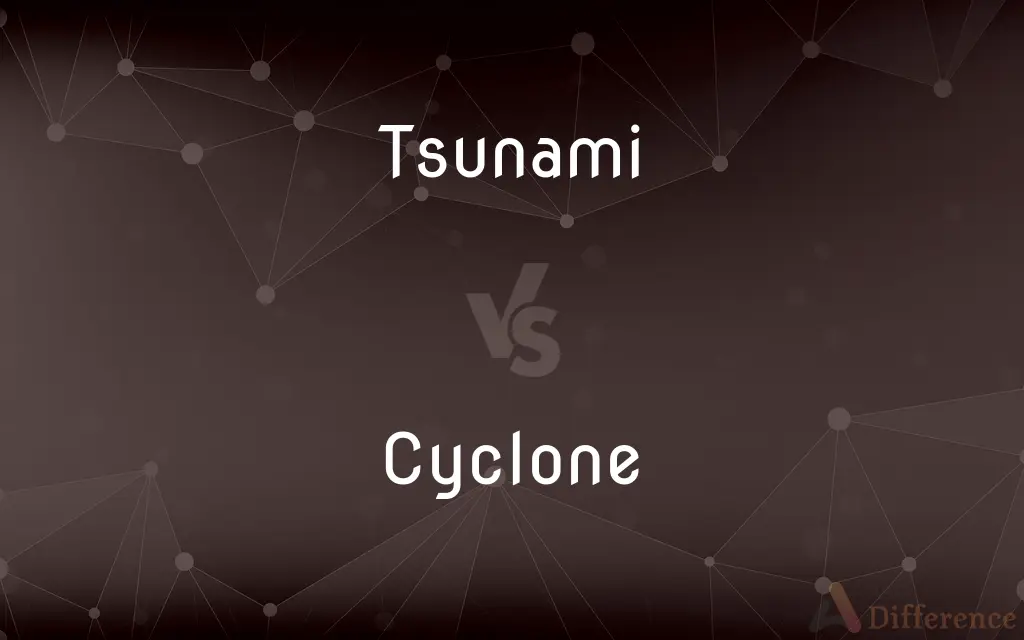Tsunami vs. Cyclone — What's the Difference?
Edited by Tayyaba Rehman — By Fiza Rafique — Updated on October 5, 2023
A tsunami is a large ocean wave caused by underwater disturbances, usually earthquakes. A cyclone is a rotating storm system formed over warm waters, characterized by high winds and, often, heavy rainfall.

Difference Between Tsunami and Cyclone
Table of Contents
ADVERTISEMENT
Key Differences
Tsunamis and cyclones are both natural disasters, but they differ in origin, nature, and the threats they pose. A tsunami typically results from underwater disturbances. The most common trigger is an undersea earthquake, especially in tectonic plate boundaries. When the ocean floor suddenly shifts, it displaces massive volumes of water, resulting in towering waves that can travel at high speeds. On the other hand, a cyclone, known as a hurricane or typhoon in different regions, originates over warm ocean waters. As warm air rises, it creates a low-pressure system, leading to a rotating storm.
From a behavioral perspective, tsunamis differ vastly from cyclones. A tsunami consists of a series of waves with extremely long wavelengths. These waves can cross entire ocean basins, and as they approach shallow waters, their height (or amplitude) increases, causing devastation upon reaching coastlines. In contrast, cyclones are characterized by their spinning motion and can cover a vast area, bringing heavy rainfall, storm surges, and powerful winds.
The aftermath of both phenomena can be catastrophic. Tsunamis can flood coastlines, erode land, and cause immediate loss of life and property. Their arrival is often sudden, with little warning, leading to more significant potential casualties. Cyclones, while typically more predictable due to modern meteorology, can devastate regions through flooding, wind damage, and storm surges. The severe rainfall can lead to secondary disasters like landslides and flash floods.
Warning systems for both disasters differ. For tsunamis, early warning centers monitor seismic activities and oceanic conditions, aiming to provide warnings to coastal communities. For cyclones, meteorological departments track storm formations and predict their paths, offering advance warnings to potentially affected areas.
In conclusion, while both tsunamis and cyclones are formidable forces of nature causing significant threats to life and property, they are inherently different in their origins, characteristics, and the challenges they present.
ADVERTISEMENT
Comparison Chart
Origin
Caused by underwater disturbances, like earthquakes.
Formed over warm ocean waters due to rising air.
Nature
Series of waves with long wavelengths.
Rotating storm system with heavy rain and wind.
Primary Threat
High waves inundating coastlines.
High winds, heavy rain, and storm surges.
Warning System
Seismic activity and oceanic monitoring.
Meteorological tracking and predictions.
Geographic Occurrence
Common near tectonic plate boundaries.
Typically in tropic regions near oceans.
Compare with Definitions
Tsunami
A large sea wave produced by an undersea disturbance.
The earthquake triggered a tsunami that hit multiple coastlines.
Cyclone
A rotating storm system originating over warm waters.
The cyclone in the Pacific was categorized as a Category 5 storm.
Tsunami
A sudden and unusually high sea wave often causing devastation.
Coastal towns were severely damaged by the approaching tsunami.
Cyclone
A low-pressure system formed over oceans, leading to storms.
The cyclone brought heavy rains and flooding to the region.
Tsunami
Oceanic waves with significant energy traveling vast distances.
The tsunami traveled across the entire Pacific Ocean basin.
Cyclone
A spinning weather system, known as hurricanes or typhoons in some areas.
The cyclone, known as a typhoon in Asia, caused significant damage.
Tsunami
Sea waves with long wavelengths, rising dramatically in shallow waters.
As the tsunami reached shallower waters, its height surged immensely.
Cyclone
In meteorology, a cyclone () is a large scale air mass that rotates around a strong center of low atmospheric pressure, counterclockwise in the Northern Hemisphere and clockwise in the Southern Hemisphere as viewed from above (opposite to an anticyclone). Cyclones are characterized by inward-spiraling winds that rotate about a zone of low pressure.
Tsunami
Oceanic phenomena often linked to tectonic activities.
The subduction zone is a common source of potent tsunamis.
Cyclone
A system of winds rotating inwards to an area of low barometric pressure, with an anticlockwise (northern hemisphere) or clockwise (southern hemisphere) circulation; a depression.
Tsunami
A tsunami ( (t)soo-NAH-mee, (t)suu-; from Japanese: 津波, lit. 'harbour wave', pronounced [tsɯnami]) is a series of waves in a water body caused by the displacement of a large volume of water, generally in an ocean or a large lake. Earthquakes, volcanic eruptions and other underwater explosions (including detonations, landslides, glacier calvings, meteorite impacts and other disturbances) above or below water all have the potential to generate a tsunami.
Cyclone
An atmospheric system characterized by the rapid inward circulation of air masses about a low-pressure center, usually accompanied by stormy, often destructive weather. Cyclones circulate counterclockwise in the Northern Hemisphere and clockwise in the Southern Hemisphere.
Tsunami
A long, high sea wave caused by an earthquake or other disturbance
The loss of human lives from this latest tsunami is staggering
Cyclone
A violent tropical storm, especially one originating in the southwestern Pacific Ocean or Indian Ocean.
Tsunami
A very large ocean wave caused by an underwater earthquake or volcanic eruption.
Cyclone
A violent rotating windstorm, especially a tornado.
Tsunami
A very large and destructive wave, generally caused by a tremendous disturbance in the ocean, such as an undersea earthquake or volcanic eruption. Tsunami are usually a series of waves, or wave train.
Cyclone
Any of various devices using centrifugal force to separate materials.
Tsunami
(figurative) A large and generally unstoppable surge.
Cyclone
(broad sense) A weather phenomenon consisting of a system of winds rotating around a center of low atmospheric pressure
Tsunami
A huge destructive wave (especially one caused by an earthquake)
Cyclone
(narrow sense) Such weather phenomenon occurring in the South Pacific and Indian Ocean
Cyclone
A low pressure system.
Cyclone
(informal) The more or less violent, small-scale circulations such as tornadoes, waterspouts, and dust devils.
Cyclone
A strong wind.
Cyclone
A cyclone separator; the cylindrical vortex tube within such a separator
Cyclone
To separate using a cyclone separator.
Cyclone
To storm as a cyclone.
Cyclone
To whirl in spirals as a result of a cyclone or whirlwind-like force.
Cyclone
To storm wildly; to be in a frenzy.
Cyclone
A violent storm, often of vast extent, characterized by high winds rotating about a calm center of low atmospheric pressure. This center moves onward, often with a velocity of twenty or thirty miles an hour.
Cyclone
In general, a condition of the atmosphere characterized by a central area of pressure much lower than that of surrounding areas, and a system of winds blowing inward and around (clockwise in the southern hemisphere and counter-clockwise in the northern); - called also a low-area storm. It is attended by high temperature, moist air, abundant precipitation, and clouded sky. The term includes the hurricane, typhoon, and tropical storms; it should not be applied to the moderate disturbances attending ordinary areas of low pressure nor to tornadoes, waterspouts, or "twisters," in which the vertical motion is more important than the horizontal.
Cyclone
A tornado. See above, and Tornado.
Cyclone
(meteorology) rapid inward circulation of air masses about a low-pressure center; circling counterclockwise in the northern hemisphere and clockwise in the southern
Cyclone
A violent rotating windstorm
Cyclone
A meteorological phenomenon with high winds and rainfall.
Coastal areas braced for the approaching cyclone.
Cyclone
A storm driven by the upward movement of warm, moist air.
The intensity of the cyclone increased as it moved over warmer waters.
Common Curiosities
What's the difference between a cyclone, hurricane, and typhoon?
These are regional names for the same weather phenomenon. "Cyclone" is a generic term, "hurricane" is used in the Atlantic and Northeast Pacific, and "typhoon" in the Northwest Pacific.
How fast can a tsunami travel?
In deep water, tsunamis can travel at speeds of up to 500-800 km/h (310-500 mph).
How long can a cyclone last?
Cyclones can last for a week or more, especially if they move over open water.
Is a tidal wave the same as a tsunami?
No, tidal waves are caused by gravitational interactions with the moon and sun, while tsunamis result from underwater disturbances.
Can we predict tsunamis?
Tsunamis can be predicted to some extent by monitoring seismic activities and oceanic conditions.
What causes tsunamis besides earthquakes?
Besides earthquakes, tsunamis can be caused by volcanic eruptions, landslides, or meteorite impacts.
Can cyclones occur anywhere?
Cyclones typically form in tropical regions over warm ocean waters.
How big can tsunamis get?
Tsunami wave heights can exceed 100 feet in some cases, especially near their source.
Can we prevent cyclones?
Cyclones cannot be prevented, but early warning systems can mitigate their impact.
Can a tsunami be caused by a cyclone?
While tsunamis are typically caused by earthquakes, cyclones can cause storm surges, which are large, tsunami-like sea waves.
What's the center of a cyclone called?
The center of a cyclone is called the "eye."
How are cyclones categorized?
Cyclones are categorized based on their wind speeds, with categories ranging from 1 (least severe) to 5 (most severe).
Why are tsunamis more common in the Pacific?
The Pacific has many tectonic plate boundaries, making it more prone to the earthquakes that trigger tsunamis.
Do cyclones always move in a spiral?
Yes, cyclones have a rotating motion, which appears as a spiral, especially when viewed from above.
Are there warning systems for both tsunamis and cyclones?
Yes, there are early warning systems for both phenomena to help reduce risks and save lives.
Share Your Discovery

Previous Comparison
Doubtful vs. Cynical
Next Comparison
Believe vs. TrustAuthor Spotlight
Written by
Fiza RafiqueFiza Rafique is a skilled content writer at AskDifference.com, where she meticulously refines and enhances written pieces. Drawing from her vast editorial expertise, Fiza ensures clarity, accuracy, and precision in every article. Passionate about language, she continually seeks to elevate the quality of content for readers worldwide.
Edited by
Tayyaba RehmanTayyaba Rehman is a distinguished writer, currently serving as a primary contributor to askdifference.com. As a researcher in semantics and etymology, Tayyaba's passion for the complexity of languages and their distinctions has found a perfect home on the platform. Tayyaba delves into the intricacies of language, distinguishing between commonly confused words and phrases, thereby providing clarity for readers worldwide.















































